Spoiler warning – minor spoilers for both Game of Thrones and A Song of Ice and Fire
When producing any work in a visual medium, creators must give attention to the physical appearance of their product. The first thing an audience interacts with is what they see – and its impact (or lack thereof) can determine whether someone engages with or abandons the material. It’s no surprise, then, that greater attention to visual detail is more likely to capture an audience. The raging successes of computer animated Disney films like Frozen and Tangled demonstrate this visual power, as do animated masterpieces like anything from Studio Ghibli. Humans respond to visual stimulus.
Detail in more classic mediums, like costuming for live-action television, carries the same impact. This fact is not lost on the creators and costume designers of HBO’s Game of Thrones (GoT). Even when watching the show in season 1, before all the money came rolling in, the costume department put in exceptional work for such a massive project. Now, sixty episodes along, there is enough material for us to take a long hard look at the costuming decisions made over the years.
Much like Kylie’s and Julia’s conclusion that Game of Thrones as a story crumbles under the lightest criticism because of its internal inconsistencies, many of the costume choices, when ever so mildly analyzed, reveal a basic lack of logic and disregard for the source material. Some even reflect broader issues occurring in the writing, particularly when it comes to the female characters.
So sit back, relax, and pull out your salt thrones as we enter what I lovingly refer to as Game of Clothes.
Daenerys Targaryen, Mother of Back Stories You Will Never Know About, Khaleesi of Leather Pants, and Queen of Color-Themed Wardrobe Choices
One of the interesting things about costume design and creation is that every single step involved must be conscious by its nature. Everything from silhouette to fabric choice to hem width must be both decided and then executed. Consequently, nothing can happen by accident or in an unconscious way – as might sometimes happen with cruddy writing because of unrealized biases.
Daenerys Targaryen of A Song of Ice and Fire wears clothing that makes sense: Dothraki leathers when she’s riding, and more formal gowns when appropriate. Daenerys of Game of Thrones wears outfits based primarily on color and always has on her leather pants and boots (even under her dresses in the hot deserts of Qarth, Yunkai, and Meereen). While there are dozens of examples of show!Dany’s strange fashion choices, let’s start with one of her first actual dresses:
Qarth Dress with Golden Belt
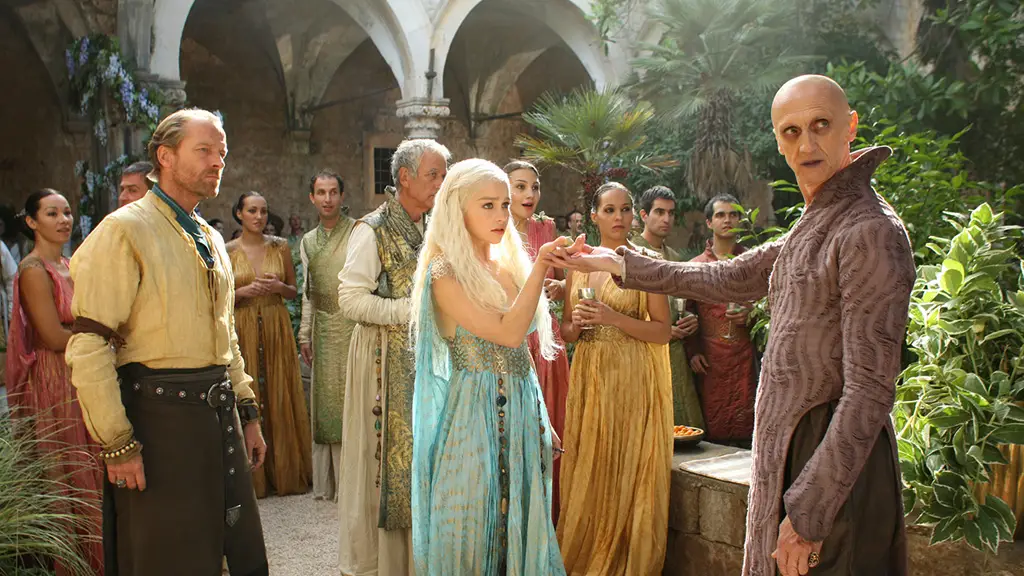
“Wincing, she shifted [Rhaegal] to her other shoulder, where he could claw her gown instead of her skin. She was garbed after the Qartheen fashion…she had taken care to go before them in flowing green samite with one breast bared, silvered sandals on her feet, with a belt of black-and-white pearls about her waist.”
I mean, nailed it, right?
Let’s get down to it. What’s the big deal? So they got the color wrong – blue instead of green, not really our concern here. No pearls? Whatever – pearls are expensive, and we wouldn’t want the creators spending money on something the audience will never see anyway! And sandals? Who needs ‘em! Sandals being an integral part of Essosi fashion and culture (differentiating it from Westerosi culture) isn’t necessary for the show when it’s clear the Essosi are exotic and different based on their skin tone, while our main character is the only blond in sight. This is color-coding for the audience’s convenience at its finest.
The above missing details reveal that the costume department probably didn’t read the books, which doesn’t shock me. And while missing these details affects world building efforts, and have some negative connotations that Essosi culture is easily dismissed in favor of catering to the main princess (a theme book!Dany directly struggles with), these aren’t the issues that struck me about this costume design. What I’m concerned with is the mysterious missing breast.
Game of Thrones is no stranger to baring it all on screen. Tyrion Lannister first appears in Episode 1 with the sex worker, Ros, who is bare-chested. Just a few episodes before show!Dany’s Qarth dress appears, Petyr Baelish describes his duel against Brandon Stark to the backdrop of two sex workers practicing naked on a bed. And in the Season 1 finale the audience sees both of show!Dany’s breasts when she emerges from the pyre with her dragons. Not only does Game of Thrones give us plenty of boobs, but it specifically gives of plenty of Dany boobs throughout the series.
And yet there is no breast here, even though the source material explicitly describes the style of dress. After considering forms of nudity in the series, I believe there are two explanations.
1. This is not a “sexy” dress or a sex scene
The vast majority of nudity on Game of Thrones occurs in conjunction with sex scenes or seduction. That is, the nudity is meant to be sexy. This is one force behind the constantly naked females but lack of male nudity, since the target audience is male.
In the case of the book!Qarth dress, the bearing of one breast is not intended to be “sexy” or sexual at all. It is simply how women wear their dresses in a culture that does not share the same type of modesty values as Westeros (#freethenipple). In Qarth, it is acceptable for a woman to expose her breasts without it automatically being sexual.
If show!Dany walked around with her boob out, it may have been scandalous to the audience at first; but once the scenes progressed, with every character ignoring her breast, and with no sexual action, the breast would have been de-sexualized to the extent that a Western audience can de-sexualize a breast. It would have just been part of the costume, as opposed to being a focus of sexual titillation (no pun intended).
Knowing what we know now about these writers – seeing the various forms of sexism play out over the seasons and their patterns in handling nudity – they would never have considered putting a boob on screen without it having a sexual purpose. The book!Qarth dress never stood a chance of coming to fruition because, in the Game of Thrones writer’s room, there’s no place for female nudity unless it’s for the male gaze.
There is another similar explanation, and that is:
2. This is not a “power” scene
There are two instances in the six seasons of Game of Thrones that have nudity in a non-sexual way, and they are basically the same scene. The first is when show!Dany emerges from the pyre at the end of season 1; and the second is when show!Dany emerges from the burned Dosh Khaleen temple in season 6. The first is a moment of great power, when show!Dany finally steps onto the world stage as a game changer with her dragons. The second is a copy/paste of that, minus any logic and with a dash more racism.
The scenes where show!Dany wears the Qarth dress are not power scenes – they’re party scenes. She’s exploring Qarth, getting some bad world-building in, and having some funny dialogue with her Dothraki bros who want to steal everything. Again, having a breast out would normalize the nudity, robbing it of its shock value, rendering it useless as bait for the audience. Anything that ruins nudity as sexual titillation or for its shock value – anything that normalizes the female body – cannot find a home on Game of Thrones.
I’m sure the explanation here is that the costume department never considered having Emilia Clarke in a one-shouldered dress (even though this was prior to her refusal to do nude scenes for seasons 4 and 5). But the reasons they couldn’t consider it come from the culture of the show, derived from the writing and the creators. The use of nudity in one scene affects its use in all scenes. When almost every use is sexual, and none are normalizing, then it’s nearly impossible for a costume designer to push that boundary.
While the mysterious missing breast was the result of patterns in the show’s writing, other design decisions with show!Dany reveal costume designers’ personal creativity – and lack of logic.
Blue is a Dothraki Color
“I like to put blues on her because they’re a reference back to Khal Drogo [her dead husband] and the Dothraki, because blue was their special color. We decided [in season one] that it was a rare natural pigment available to them in their region, so it’s sort of her weird tribute to him. So yes, blue is a very important color for her, and I think she’ll carry that through for a while.” – Michelle Clapton, lead costume designer for seasons 1-5 of Game of Thrones
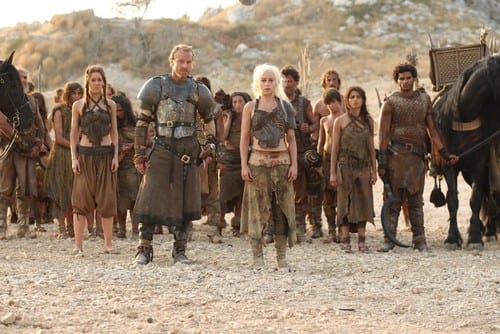
Back in season one – while the writers were busy creating a fourth child for show!Cersei and giving all of Catelyn Stark’s material to any man in the same room – Michelle Clapton and crew (hereinafter “Clapton & Co.”) were hard at work making shit up for no reason. Here, Clapton & Co. describes how they, the costume team, invented a cultural aspect for the Dothraki. This decision had ongoing ramifications felt through season four:
“Daenerys wears striking blue dresses – instead of the red and black colors associated with House Targaryen that her brother Viserys wore – because blue is the Dothraki power color.”
It’s not inherently a negative for costume designers to add detail, and it can be a great boon to any complex show or movie when it’s done well. Clapton & Co. actually added great details to certain costumes that create depth and intricacy where it did not exist before – one being to add scale-like elements to show!Dany’s outfits. It makes sense that show!Dany is drawn to clothing that mimics dragon scales, and the ability to create that texture exists within the confines of the universe (reptile leather, embroidery, and other sewing techniques). The problem arises when Clapton & Co. add details that do not fit within the world. Choosing blue as a “special Dothraki color” is a great example.
Let’s break it down. Clapton & Co. chose the color blue. As mentioned earlier, costume decisions are, by their nature, conscious. At some point, some designer chose a single color to be the “special” color. A few come to mind for the Dothraki: red for blood; black for the Nightlands; green for the sea they live on. But blue is particularly problematic. See, the Dothraki specifically fear the ocean – a massive, expansive, never-ending blue body of water.
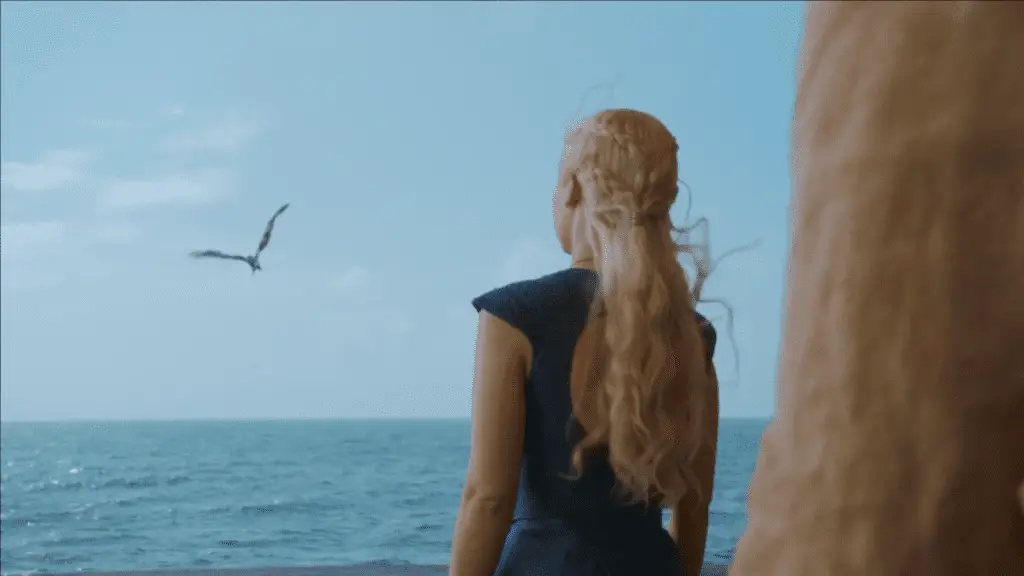
It is not only book cannon, but the audience is reminded repeatedly that the show!Dothraki fear the “poison water” because their horses cannot drink it or cross it. Show!Dany even makes a point of praising the few Dothraki who follow her across the sea to Astapor, and the audience sees the Dothraki wretching from sea-sickness and fear during the voyage. Of every color in the rainbow, blue makes the least sense. The Dothraki do not encounter good or powerful things that are blue. Corpses turn slightly blue. Mold on bad food is blue. And again, most importantly, blue is the color of the ocean the Dothraki universally fear.
This is a terrible oversight, and it has an affect on the world. Getting an audience to invest in your story and your characters requires them to trust you. They must buy what you are selling, and they must buy it completely or the suspension of disbelief is broken. Especially in a fantasy setting, the audience could easily tip against you if just one small thing is out of place. We spent season 1 watching a woman somehow magically related to dragons ride horses through a sea of grass and have a witch kill her unborn son while a knight battled a bloodrider outside the tent – the audience deserves credit for swallowing so much fantasy. Part of costuming is bolstering that believability.
The problem with blue being a “Dothraki color” is that it is unbelievable. It hurts the creator’s credibility and threatens that suspension of disbelief. First, it’s plainly wrong – a modicum of critical thought applied to the statement “blue is a Dothraki color” or “blue is a special Dothraki color” destroys the concept. Second, once you realize how illogical the idea is, it becomes laughable. It’s funny that Clapton & Co. picked the one impossible color, of all colors! It’s entertaining that they think a society terrified of the ocean would worship the color blue. It’s like if the Dothraki’s special spiritual animal was a fish. It’s just humorous at this point. And it hurts the legitimacy of the visual adaptation.
On top of this gross oversight, if blue is intended to be a “Dothraki color”, then clearly the horde did not get the memo.
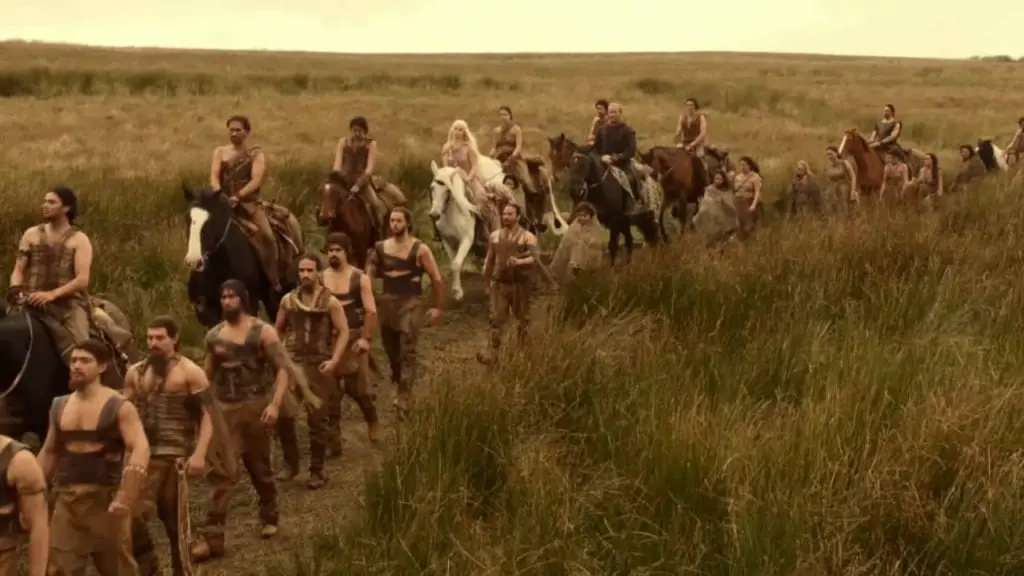
If you’re going to make a bad decision, attempt to sell it to me with your conviction. At least David Benioff and Dan Weiss (D&D) are consistent in their bullshit. The audience knows to expect sexism and shiny objects. The whole show is marketed as boobs and dragons. I know with each episode what I’m getting, and it’s not ever a great work of modern media.
But Clapton & Co. decided blue was a special Dothraki color and executed this decision rarely throughout season 1. The most blue we get is during the Dothraki wedding is episode 1, and you have to look pretty hard at those background extras to catch a flash here and there. Drogo wears blue paint on his shoulders for some of his scenes. But I guess the special Dothraki power color wasn’t necessary for when the khalasar raided the Lhazareen.
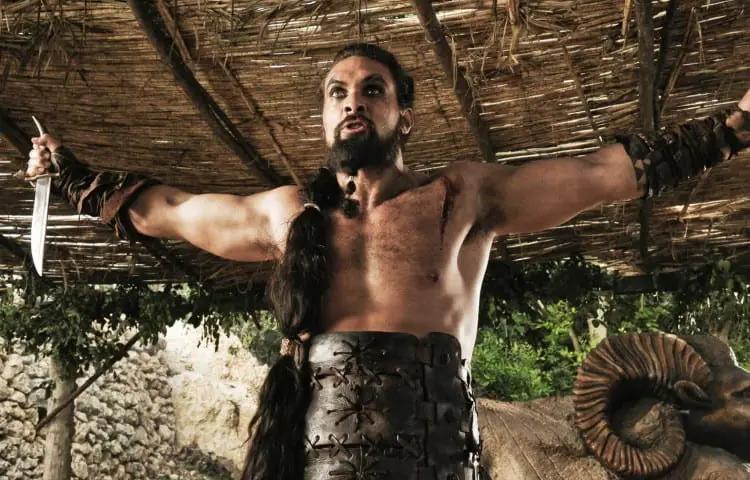
The inconsistency of application to the Dothraki, followed by the consistent application to Dany, calls into question the true motive behind such a color choice. Here’s my two cents: Clapton & Co. picked blue as a “special Dothraki color” without any particular thought, and later discovered that Emilia Clarke, with blonde hair and light eyes, also looked great in blue. They dressed Emilia Clarke in a light-blue and gold dress in season 2, got a roaring response, and proceeded to use blues in season 3 (they have a tendency to color-code characters’ outfits, like Cersei and Margaery). Blue made Dany stand out from other female characters, and also broke up the brown-ish desert landscapes she traversed. Clapton & Co. later realized the same color was used for both the Dothraki and for Dany. Only then did they make the connection and build this back story that show!Dany is very attached to the color blue because of Khal Drogo. Indeed, Michelle Clapton never made mention of the special blue color until after season 3 aired.
This whole criticism of the “special Dothraki color” being blue may seem nit-picky. I mean, it’s not like there’s another bright, eye-catching color that could have easily symbolized power for this nomadic barbarian horde.
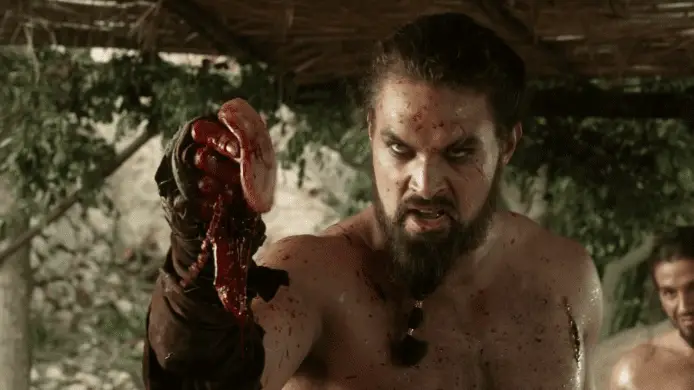
Clapton & Co. actually addressed the color red, assigning it to another khalasar, like a team color.
“Khalasars sometimes differentiate themselves by decorating their bodies and their horses with different colors of paint. For example, Khal Drogo’s khalasar used blue paint, but Khal Jhaqo’s khalasar uses red paint. Such dyes are expensive so they tend to only use them for special occasions”
If this is what the idea evolved into, then we’re in a whole new world of creative. I’m sure it really matters to villagers exactly which khalasar sacked their home. And the only way they could possibly know who stole their shit and enslaved them is by checking out those flashy team colors!
Team colors don’t work unless everyone has them. In this culture team colors are irrelevant anyway. The khals attack each others’ khalasars indiscriminately, with no favoritism or alliances. That is what makes the Dothraki weak in comparison to organized fighting forces – perhaps paralleling another unorganized horde that another main character has to deal with after somewhat integrating into the culture.

This whole color-thing is one example of how the costume department wastes its time on details that don’t make any sense anyway. There was no need for the Dothraki to have a special color; there was no confusion over which Dothraki horde belonged to which Khal; and the chosen color contradicts the established culture and lore. Clapton & Co. wasted time and energy on a pointless, counter-productive detail.
Unsurprisingly, this happens a lot.
Momma Targ’s Amazing GPS Jewelry
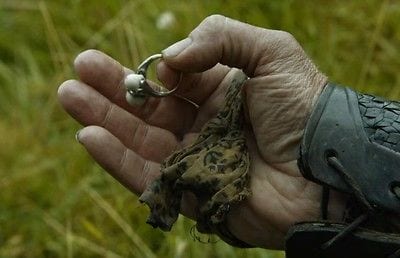
Clapton & Co. decided in season 1 that show!Dany would always wear this ring. According to their imagined lore, this is show!Dany’s mother’s ring. Show!Dany managed to keep her mother’s ring all these years, and she’s worn it consistently since season 1. As Emilia Clarke herself said, “This ring is, fundamentally, the only thing that Dany’s had from day one, Season 1. It’s her mother’s ring.”
First, there is truth to the claim that show!Dany consistently wears the ring. It switches fingers, but if you’re looking for it, you can find it.
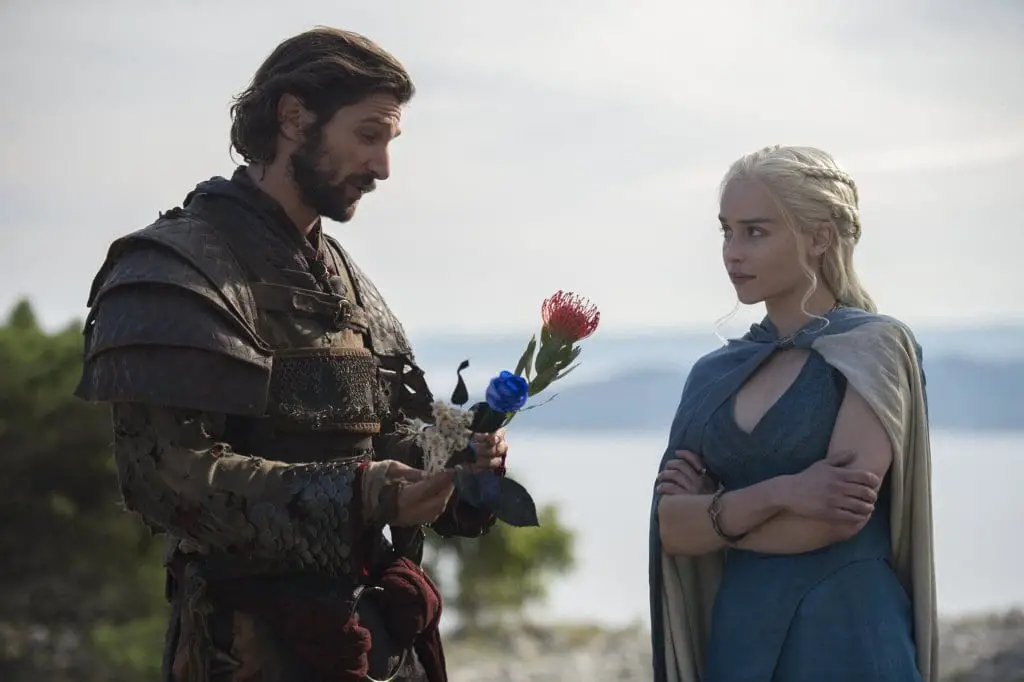
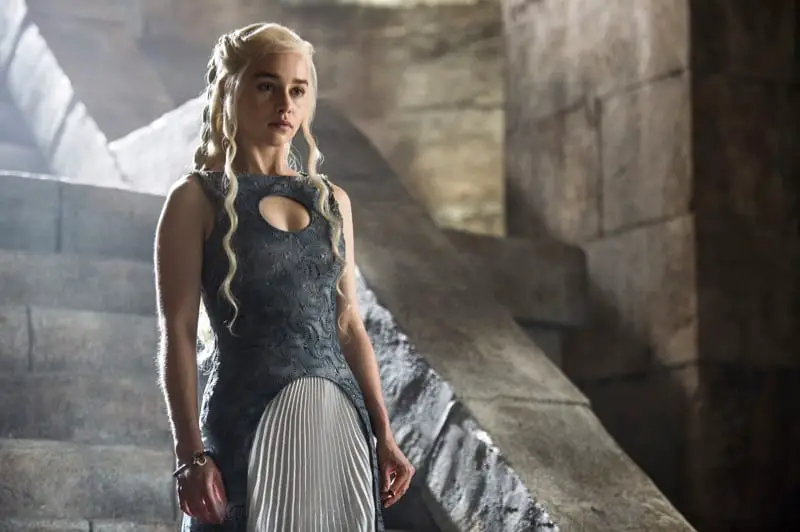
However, I hotly contest that the ring in episode 1 is the same ring.
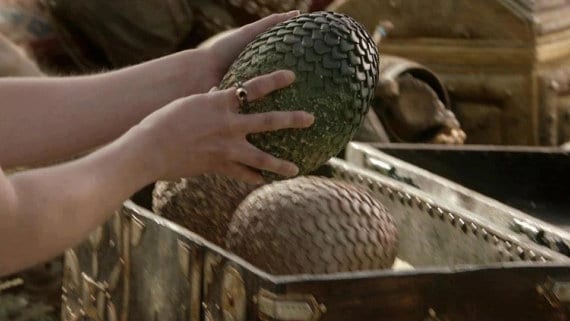
And of course, if you look closely, there are some misses.
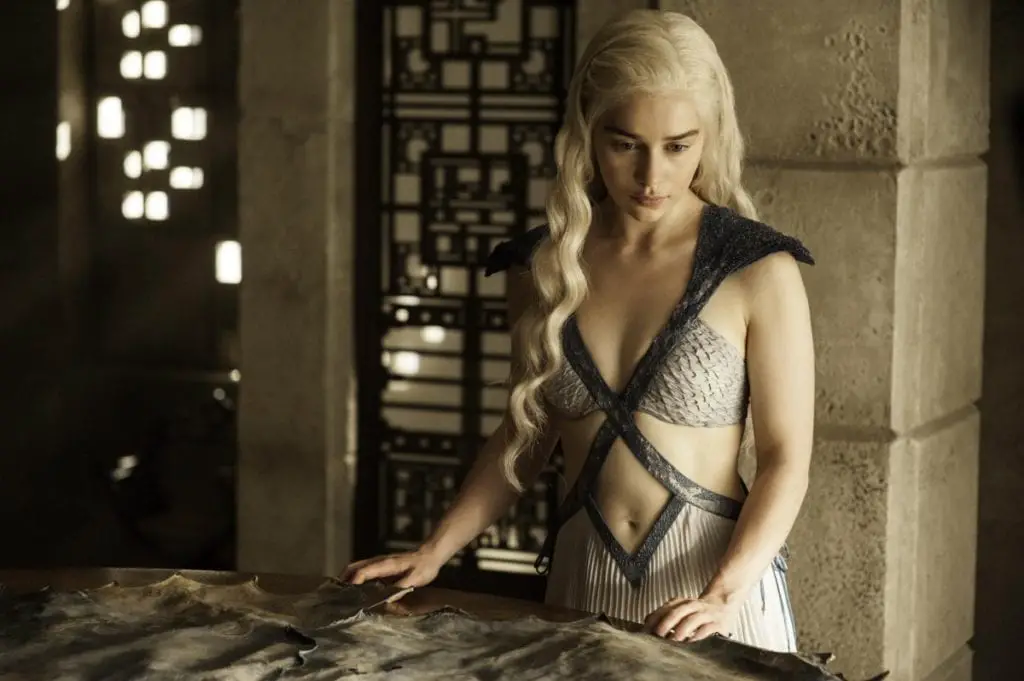
That’s fine, though. Dany’s ring is a detail – it doesn’t have any plot significance shown on-screen as part of show-cannon. Then they certainly would have remembered to include it in every scene.
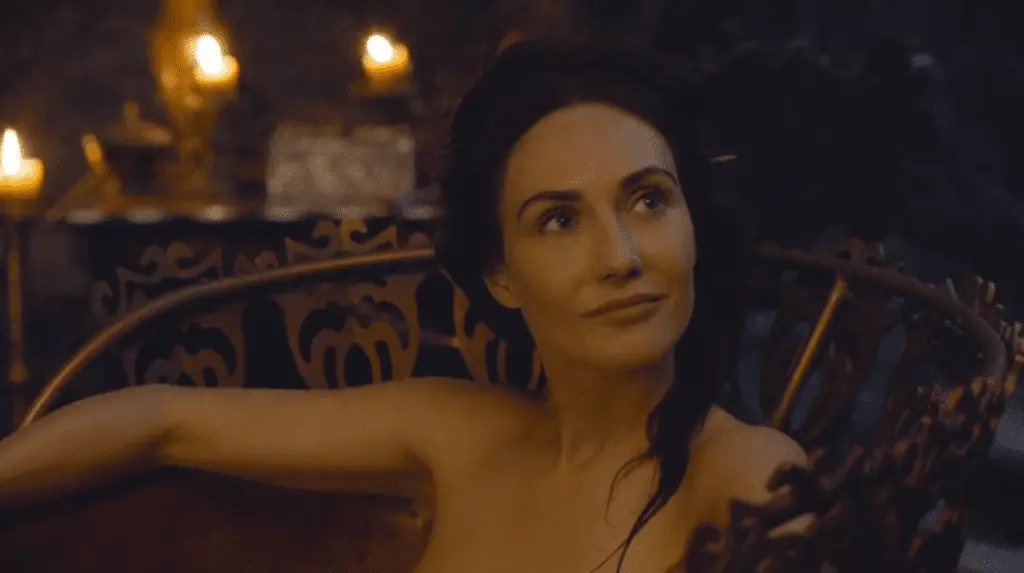
At least we have adequate execution accompanying this ring back story. But let’s look at the story itself. Game of Thrones Wiki does a good job summarizing what is established by Clapton & Co.:
“The one constant throughout all of Daenerys’s travels and costume changes is the ring she wears on one of her fingers, which has been present since her first appearance in the Season 1 premiere. According to Emilia Clarke, while it is unstated, this is actually supposed to be her mother’s ring. Queen Rhaella Targaryen died giving birth to Daenerys on Dragonstone, a few weeks before loyalists smuggled her and Viserys across the Narrow Sea to the Free Cities. She never knew her mother and lost absolutely everything else from her family’s home that she never even knew – Viserys even had to sell their mother’s crown at one point just to keep from starving – but some way, somehow, Daenerys managed to hold onto a ring that belonged to her mother Queen Rhaella. She usually wears the ring on her left index finger, though she often wore it on her right index finger in Season 1.”
Based on book canon – and we have no reason to believe this is different from the show cannon – Queen Rhaella died while giving birth to Daenerys, who was subsequently taken to Essos with her brother. That means Daenerys was an infant when she, Viserys, and all of their belongings, were transported. Viserys, by contrast, was eight or nine years old (Viserys was born is 276 AC, with Daenerys born in 284 AC). This age difference put Viserys in a position of responsibility and power. He controlled all of their property, including their crown jewels. Consequently, Viserys ended up selling all of the Targaryen jewels throughout his time in Essos. Daenerys, a child eight years younger than her brother, is powerless to stop him.
But somehow, somehow, show!Dany managed to hide show!Rhaella’s (hereinafter “Momma Targ’s”) ring from her brother and all the adults caring for her. Please dear reader, take a moment to imagine any infant or toddler you’ve ever known, and think about how that child would possibly hide a physical object from their caretakers for two decades. It just makes no sense. Children, particularly infants and small children, do not have the capacity or physical ability to take and hide an object that well for that long. Especially a child living as a guest in someone else’s home, beholden to that person’s servants; and especially hiding an object that would be searched for, as Viserys would know what valuables they owned.
Here, we run into the same problem as before: the idea sounds cool, and maybe even heartwarming in this case, but it crumbles under the slightest critique. Any rational mind can pick apart this concocted back story. The weakness of it reveals a true lack of thought and critical thinking skills. It shows again how little the costume designers care about the source material – an issue I firmly place on D&D’s shoulders, as they set the tone for the entire project. And, finally, we see again overexertion of “creativity” used on a pointless detail that could not exist within the confines of the show cannon.
The fact that she proceeds to wear Momma Targ’s ring on a necklace once it’s returned to her makes it worse. The existence of the ring itself makes no sense, but this style is just anachronistic and a bit stereotypical of a white high school girl.
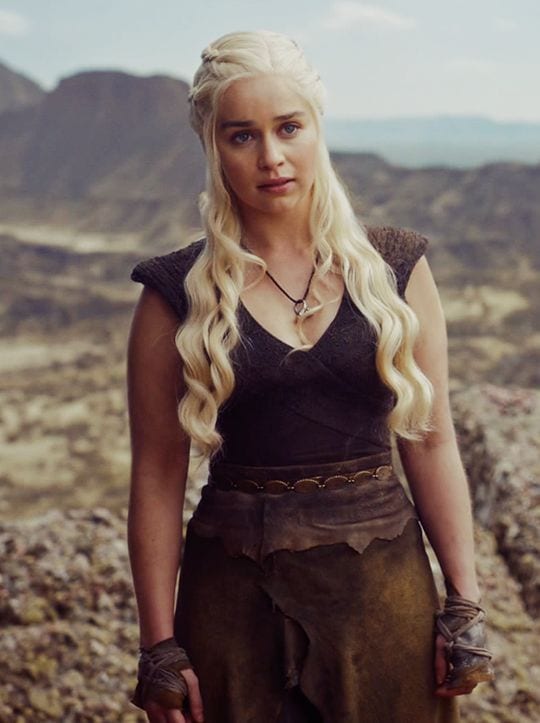
Note that this specific design decision, made in season 6, was not Clapton & Co.’s work (Michelle Clapton left the show by this point).
All in all, this ring causes way more problems than it’s worth. Clapton & Co., if you want to put a ring on Dany because it’s pretty, just put it on her. You don’t need an explanation. Hell, this show doesn’t explain anything else.

While someone over at the costume department strained to include a ring the audience barely sees with a back story the audience never learns, some others were drunk on Dothraki fermented milk when making final calls on show!Dany’s appearance (spoiler: the drunks were D&D).
Contacts Are Uncomfortable
In the long list of things D&D have said that I don’t believe, this is near the top. According to the creators’ statements on the Blu-Ray GoTs discs, both show!Viserys and show!Dany were originally shot wearing purple contact lenses. But D&D scrapped the contact idea so early that it never made it into the show, saying that:
“Actors act with their eyes, and [the lenses] really hurt the emotion.”
Okay, pause. First, if your actor can’t express emotion through a contact lens, then they are not a good actor. Part of the job is becoming the character – that includes costume, make-up, setting, body movement, and even the very words that come out of their mouth. An actor, by the nature of the profession, must be able to act through any hindrance or disguise attached to their person. Contact lenses are just another part of that. If D&D really didn’t feel the emotion coming from Emilia Clarke because she was wearing purple contacts, then there was another problem going on.
Based on the fact that Emilia Clarke totally nailed her roll as Daenerys in seasons 1 and 2 (back when she showed emotion on her face), I doubt that this “emotion” excuse is true. Emilia Clarke acts her face off when provided the right setting. I mean, just watch five minutes of Me Before You and try to count the number of faces this lady makes!

Since I have no other reason to believe anything D&D say (you’ve burned me too many times, boys), I’ll just go ahead and list this in the not true category. More likely, the show attempted to use color contacts once and the two actors – who are not normally contact wearers – were a bit befuddled. It’s normal to be uncomfortable when you try contacts for the first time. If they’re terribly painful, get another brand. Colored contacts are especially bizarre because they somewhat limit your vision, but you ultimately adapt to it. Not to mention plenty of other actors on plenty of other shows wear colored contacts without issue. Plenty of actors who have to wear them for way more episodes than GoT.

I also personally have worn purple colored contacts for 10+ hours for my own Daenerys cosplays. It sucks, but I do it so everyone knows I’m book!Dany. But then again, I’m concerned with accuracy in my own work.
And that’s what this all really comes down to – accuracy. Consistency. Respect for the source material. Because at the end of the day, if D&D really cared about preserving the distinct Targaryen look of platinum hair and violet eyes, they would have found a way to do it. They would have gotten better contacts. They would have told Emilia Clarke wearing them was part of her job. They would have used some of that CGI budget to alter the color. It is just such an easy problem to solve that the only explanation is disregard for the story and its themes, and laziness.
Note that this is not a disregard for detail. As discussed above, there is extreme detail in certain circumstances, and certainly in many places not discussed here. The issue is the way the show prioritizes these details. Why do we end up with an explanation of show!Dany’s blue dresses, but don’t get her wearing sandals in Qarth? Why do we get a back story that never makes it to the screen, but don’t get purple contact lenses? It’s because of the priorities of the creators and the costume department.
Looking at just this sliver of the production, it seems the priority is creating the story D&D want as opposed to adapting the story George R.R. Martin told. D&D encroach on these characters by chipping away details here and there, and adding things in. Clapton & Co. make it all possible, definitely taking their direction from D&D. It’s almost like a strange appropriation of the novels. D&D take something that is clearly not theirs (the A Song of Ice and Fire story), as it belongs entirely to George R.R. Martin, and use it for their own purposes (making all the monies) with no regard or respect for its originally purpose (themes and shit).
The two most important physical aspects of a Targaryen are their blond hair and purple eyes. The show got one of them right. They failed the test with 50%. Unfortunately for the viewer, they don’t get to make up their work – each shitty decision they made has already had rippling affects on the show.
But these are just preliminary hypotheses about how the costume design interacts with or is dictated by the rest of the show creation. We must look further and with a critical eye at other examples of costume design to truly determine the extent of this connection.
Keep your salt thrones ready for future installments of Game of Clothes.


